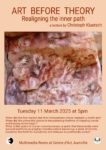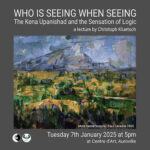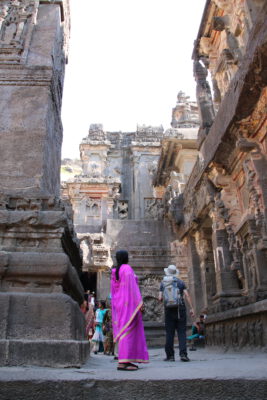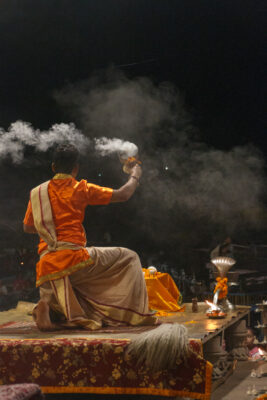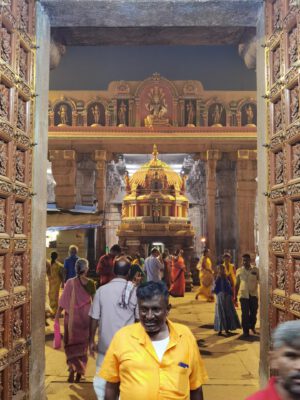A major show of the woks from Amitabh Sengupta is on display at Kalakendra Art Gallery, Bharat Nivas, Auroville. In cooperation with Sarala’s Art Centre 70 paintings predominantly from the last decade can be seen. For the opening of the exhibition on Dec 16th 2022 the secretary of Auroville and the director of the Alliance Français lit the candle.
Amitabh Sengupta was born in Calcutta in 1941 and graduated from Govt. College of Arts & Crafts, Calcutta in 1963. From 1966 to 1969 he received a scholarship for the Ecole des Beaux-Arts in Paris, where he was witnessing the 68 student revolts. From 1977 until 1981 he joined the University of Port Harcourt in Nigeria, where he became Head of Creative Arts. He exhibited in India, Nigeria, Europe, and USA and currently lives in Calcutta.
The works by Amitabh Sengupta show a vast spectrum of styles. It is impressive to see how much he engaged with western modernist tradition and yet maintained his roots in Indian traditions. We can see this in the colours, the traces of written words, the iconography. Going through the exhibition there are echoes of Pablo Picasso, Henri Matisse, Cy Twombly, Anselm Kiefer, Pierre Soulage, Jasper Jones, Paul Klee and many more.
[Best_Wordpress_Gallery id=“17″ gal_title=“Amitabh Sengupta“]
I was wondering about that rich reference and the echoes of western modernity, and found the answer in Amitabh Sengupta’s writings. In his “Memoir of an Artist” from 2014 he makes several times a reference to Rabindranath Tagore, most people will be familiar with his name as the first Nobel Prize winner in India. At the end of the chapter ‘Indian Contemporary Art – an alternative modernity’ Amitabh Sengupta writes: “In the absence of social dialogue, art is facing another challenge. The priorities of art commerce and global marketing are imposing pressure to remain ‘modern’ as constant reference to global trends. This was predicted by many, for example, Tagore, expressed admiration about western cultures, at the same time warned against the risk of coercion, which they saw a built-in process in the system.“ Amitabh Sengupta being part of the Bengal Art school takes Tagore to heart.
Art historical narratives
We can recall Rabindranath’s poem Namaskar to Sri Aurobindo published 1907 as it is well known. Rabindranath admired Sri Aurobindo’s fight against colonialism and oppression and supported him during his time in prison. Aurobindo’s book Renaissance in India with articles from 1918-21 comes to mind. But while the western eye can learn from Aurobindo how to see Indian Art through the Indian perspective, Rabindranath warns of the power of modernism in the visual arts for Indian Artist.
Here lay the roots of the negotiation between western modernist and Indian culture in the 20th century. We see why the big show of Amitabh Sengupta fits into the Kalakendra Art Gallery, Bharat Nivas, Auroville. His work is informed by these discussions and addresses the struggles which western academic art historian theories have with not western art. Sengupta’s oeuvre speaks to the difficulties Indian artists faced during the middle of the 20th century to be seen internationally.
In 2021 Sengupta’s “The History of Modernism in India” was published, a 200 pages thick book that celebrates diversity in India and warns of the misconception by the west of a “uniform and monolithic Hindu structure”. Chapter 6 deals with Rabindranath Tagore’s Dialectics of Art. How should the art of a young nation like India, that also has one of the oldest cultural histories in the world, respond to the dominating western modern concepts? We know that western modernism drew inspiration from its colonial exploitation of the other parts of the world (the prominent examples are Van Gogh, Picasso and Gaugin). That mistake may not be repeated by artist in countries that gained independence through painful paths.
Fluid mixtures
On Dec 20 2022 there was an artist talk planned. Art historian Dr. Ashrafi Bhagat gave an introduction lecture on the relevance of Amitabh Sengupta for the defining decades of the 1960ies in India. Artists had to find their voice, while connecting to the dominant western discourse, maintaining, and developing their own style. It was difficult, as there was criticism from all sides, either it was too western or not western enough, too traditional or not traditional enough, too subjective or not expressive enough… Amitabh Sengupta was an extraordinary productive artist, who masters many techniques like painting, drawing, printing, writing on the highest level. He is rooted in Indian history and its visual language and creates pictorial spaces that contain cultural memories, realistic spacial representation on an abstract plane, juxtaposed with remanences of signs and geometrical forms.
Walking through the exhibition, one sees that the pictorial spaces in his series called ‘Pyramids’ or ‘Inscription’ are abstract composition with semiotic echoes, that activates an inner space that is associated with the path of mediation since the Vedic texts. Amitabh Sengupta’s art is not explicitly spiritual, but it becomes sensible that the inner experience, the conscious mind, the creative expression, and the pictorial representation are interlinked within his body of work. Amitabh Sengupta however does not shy away from commentary on global issues with his drawing relating to the Covid-19 crises or his paintings relating to topics of urbanization and globalization.
Amitabh Sengupta voice is strong and manifests an intermiscence, i.e. a mixture of sensations, styles, thoughts, signs, space and memory that reminds me of movement of thoughts in Gilles Deleuze’s philosophy and Sri Aurobindo’s commentary on the Kena Upanishad. There that strange word of ‘intermiscence’ appears at a place that explains the creations of rhythms and forms.
For Deleuze art is thought in matter, it is also a territory in which we build our home – literally and metaphorically. The different material elements in Amitabh Sengupta’s work, the planes of composition, the connection of signs, the yantras of geometrical shapes, the pictorial space and memory invite the viewer to explore his/her inner space, where one defines home. It doesn’t matter from where you come, Amitabh Sengupta’s work invites everyone on that journey. Whether this is some sort of ‘post-post -ism’ is not relevant. That is the power of art that dares to address existential questions.
Further readings:

